 W
WA Roman mosaic is a mosaic made during the Roman period, throughout the Roman Republic and later Empire. Mosaics were used in a variety of private and public buildings, on both floors and walls, though they competed with cheaper frescos for the latter. They were highly influenced by earlier and contemporary Hellenistic Greek mosaics, and often included famous figures from history and mythology, such as Alexander the Great in the Alexander Mosaic.
 W
WThe Alexander Mosaic is a Roman floor mosaic originally from the House of the Faun in Pompeii that dates from c. 100 BC. It is typically dated in the second half of the century between 120 and 100 B.C. It depicts a battle between the armies of Alexander the Great and Darius III of Persia and measures 2.72 by 5.13 metres. This work of art is a combination of different artistic traditions such as Italic, Hellenistic, and Roman. The mosaic is considered “Roman” based on the broader context of its time and location in relation to the later Roman Republic. The original is preserved in the Naples National Archaeological Museum. The mosaic is believed to be a copy of an early 3rd-century BC Hellenistic painting.
 W
WThe Antioch mosaics are a grouping of over 300 mosaic floors created around the 3rd century AD, and discovered during archaeological excavations of Antioch between 1932 and 1939 by a consortium of five museums and institutions. About half of the mosaics are housed at the Hatay Archaeology Museum in Antakya, with others currently residing at the Worcester Art Museum, Museum of Fine Arts, Boston, Baltimore Museum of Art, Harvard University and Princeton University Art Museum among others. The mosaics range in design from realistic imagery and scenes, to purely geometric patterns.
 W
WBoxford Roman mosaic is a mosaic at Boxford, West Berkshire, England, rediscovered during an archaeological dig in August 2017. It dates from the Roman period. The 4th century (AD) mosaic is over 6 metres (20 ft) long. Its central panel is thought to show Bellerophon, at the court of either Iobates or Proteus, battling Chimera.
 W
WThe Circus Games Mosaic is a 2nd-century Roman mosaic depicting a chariot race in quadrigas. It was discovered in 1806 in the Ainay district of Lyon and is now on display in the Gallo-Roman Museum of Lyon.
 W
WThe House of Eirene is an ancient Roman peristyle house with lavish mosaic floors in Philippopolis, built in the middle of the 3rd century AD in the provincial capital of Thracia. It is named after the image of the Greek goddess depicted in the central mosaic.
 W
WThe Mosaic de la Font de Mussa is a Roman mosaic found in Benifaió and that dates of the 1st or 2nd century. It is located into the Museum of Prehistory of Valencia, where is one of the most highlighted pieces.
 W
WThe Gladiator Mosaic is a famous mosaic of gladiators measuring about 28 meters, dated to the first half of the 4th century. It was discovered in 1834 on the Borghese estate at Torrenova, on the Via Casilina outside Rome. The antiquities which reinvigorated the Borghese Collection after it had shrunk following the sale of much of the collection to Napoleon I.
 W
WThe Hinton St Mary Mosaic is a large, almost complete Roman mosaic discovered at Hinton St Mary, Dorset, England. It appears to feature a portrait bust of Jesus Christ as its central motif. The mosaic was chosen as Object 44 in the BBC Radio 4 programme A History of the World in 100 Objects, presented by British Museum director Neil MacGregor.
 W
WThe Judgement of Paris is the theme of a mosaic from the early second century AD, discovered in 1932 in Antioch. It is one of the most important mosaics from the ancient city, which was located a short distance from the site of modern Antakya (Antioch). The mosaic is normally housed in Paris at the Louvre, although it has been known to go on tour. In 2007 it was scheduled to feature in an itinerant exhibition of important pieces that the Louvre organised in the United States.
 W
WThe Lopen Roman Mosaic is a Roman mosaic, probably from a Roman villa, in the village of Lopen, Somerset, England.
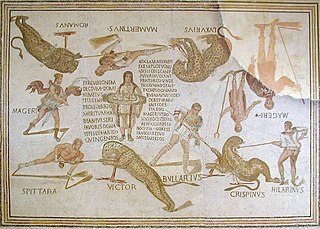 W
WThe Magerius Mosaic is a 3rd-century Roman mosaic discovered in 1966 in the Tunisian village of Smirat and presently displayed in the Sousse Archaeological Museum. The mosaic presumably decorated a country villa belonging to a man named Magerius.
 W
WThe Mosaic of Dominus Julius is a late fourth-century or early fifth-century floor mosaic that was put into in the estate of Dominus Julius in Carthage. This mosaic is a reflection of daily life and an explicit communication of the status and wealth of the owners, and what their life consisted of. It is composed of three registers (levels), and focuses on an image of a dwelling in the center, surrounded by images of leisurely activities of the owners.
 W
WThe Museum of Mosaics is a museum in the town of Devnya in Varna Province, northeastern Bulgaria. The museum, built on top of a large ruined Roman villa from Late Antiquity, exhibits mosaics from the Roman and early Byzantine city of Marcianopolis, as well as other archaeological artifacts.
 W
WThe Palestrina Mosaic or Nile mosaic of Palestrina is a late Hellenistic floor mosaic depicting the Nile in its passage from the Blue Nile to the Mediterranean. The mosaic was part of a Classical sanctuary-grotto in Palestrina, a town east of Ancient Rome, in central Italy. It has a width of 5.85 metres and a height of 4.31 metres and provides a glimpse into the Roman fascination with ancient Egyptian exoticism in the 1st century BC, both as an early manifestation of the role of Egypt in the Roman imagination and an example of the genre of "Nilotic landscape", with a long iconographic history in Egypt and the Aegean.
 W
WOpus sectile is a form of pietra dura popularized in the ancient and medieval Roman world where materials were cut and inlaid into walls and floors to make a picture or pattern. Common materials were marble, mother of pearl, and glass. The materials were cut in thin pieces, polished, then trimmed further according to a chosen pattern. Unlike tessellated mosaic techniques, where the placement of very small uniformly sized pieces forms a picture, opus sectile pieces are much larger and can be shaped to define large parts of the design.
 W
WOpus tessellatum is the Latin name for the normal technique of Greek and Roman mosaic, made from tesserae that are larger than about 4 mm. It is distinguished from the finer opus vermiculatum which used tiny tesserae, typically cubes of 4 millimetres or less, and was produced in workshops in relatively small panels which were transported to the site glued to some temporary support. Opus tessellatum was used for larger areas and laid down at the final site. The two techniques were often combined, with small panels of opus vermiculatum called emblemata at the centre of a larger design in opus tessellatum. The tiny tesserae of opus vermiculatum allowed very fine detail, and an approach to the illusionism of painting. There was a distinct native Italian style of opus tessellatum using only black on a white background, which was no doubt cheaper than fully coloured work.
 W
WOpus vermiculatum is a method of laying mosaic tesserae to emphasise an outline around a subject. This can be of one or more rows and may also provide background contrast, e.g. as a shadow, sometimes with opus tessellatum. The outline created is often light and offset by a dark background for greater contrast. The name opus vermiculatum literally means "worm-like work", and has been described as one of the most demanding and elaborate forms of mosaic work. Usually opus vermiculatum is meant to put emphasis on the main design and foreground details of a work, using a smooth and flowing halo-effect. Sometimes it was used only around the head of a figure. The tesserae used were often square but can be variously shaped.
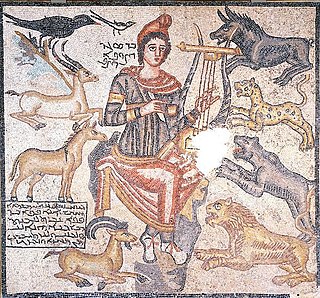 W
WOrpheus mosaics are found throughout the Roman Empire, normally in large Roman villas. The scene normally shown is Orpheus playing his lyre, and attracting birds and animals of many species to gather around him. Orpheus was a popular subject in classical art, and was also used in Early Christian art as a symbol for Christ.
 W
WPlato's Academy mosaic was created in the villa of T. Siminius Stephanus in Pompeii, around 100 BC to 79 AD.
 W
WSidi Ghrib is a Tunisian archaeological site about forty kilometers south-west of Carthage and four kilometers from Borj El Amri, known for its beautiful Roman mosaics.
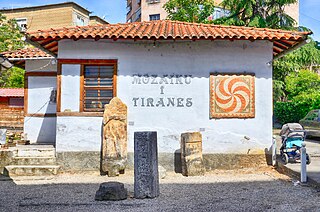 W
WThe Tirana Mosaic is a landmark in Tirana, Albania.
 W
WThe popularly named "Tomb of the Julii" survives in the Vatican Necropolis beneath St. Peter's Basilica. The serendipitous discovery near the crypt has a vaulted ceiling bearing a mosaic depicting Helios with an aureole riding in his chariot, within a framing of rinceaux of vine leaves. The mosaic is dated to the late 3rd century to early 4th century. Other mosaics in this tomb depicting Jonah and the whale, the good shepherd carrying a lamb, and fishermen have encouraged its interpretation as a Christian tomb.
 W
WVilla Armira is a 1st-century suburban Roman villa in southeastern Bulgaria, located in the proximity of Ivaylovgrad, Haskovo Province. Discovered in 1964 during reservoir construction, it is a primary historical attraction to the Ivaylovgrad area. It is classified as a monument of culture of national importance.
 W
WThe Villa Romana del Casale is a large and elaborate Roman villa or palace located about 3 km from the town of Piazza Armerina, Sicily. Excavations have revealed one of the richest, largest, and varied collections of Roman mosaics in the world, for which the site has been designated as a UNESCO World Heritage Site. The villa and artwork contained within date to the early 4th century AD.
 W
WThe Villa Romana del Tellaro is a Roman villa dating from the late Roman Empire on Sicily in southern Italy. It is located south of Noto in the province of Syracuse.
 W
WThe Villa Romana di Patti is a large and elaborate Roman villa located in the comune of Patti in the province of Messina on Sicily.
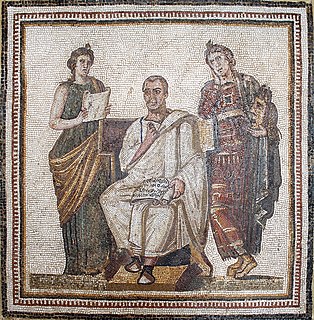 W
WThe Mosaic of Virgil is a mosaic found on the site of the ancient Hadrumetum and currently preserved in Bardo National Museum in Tunis, where it constitutes one of its key pieces. It is currently the oldest portrait of the Latin poet Virgil.
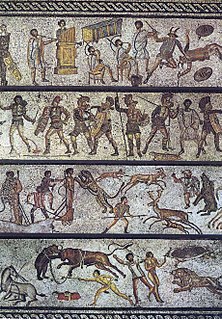 W
WThe Zliten mosaic is a Roman floor mosaic from about the 2nd century AD, found in the town of Zliten in Libya, on the east coast of Leptis Magna. The mosaic was discovered by the Italian archaeologist Salvatore Aurigemma in 1913 and is now on display at The Archaeological Museum of Tripoli. It depicts gladiatorial contests, animal hunts, and scenes from everyday life.